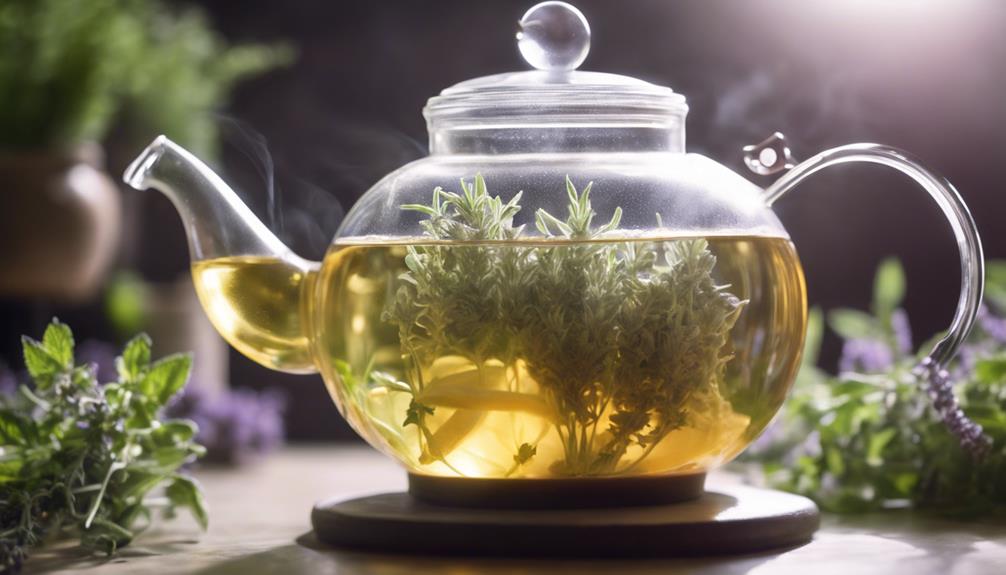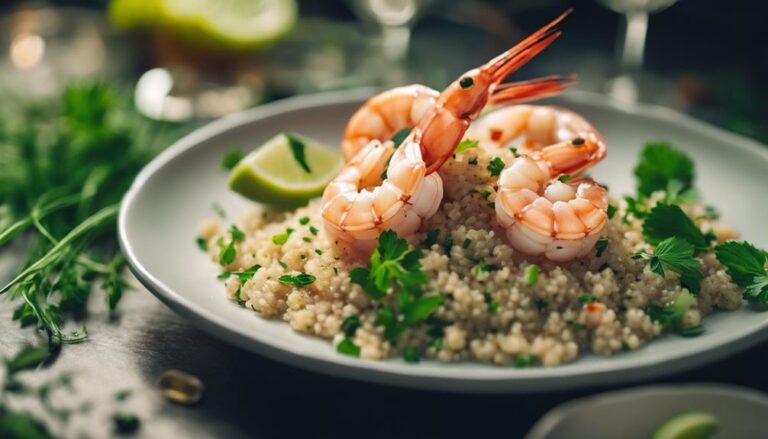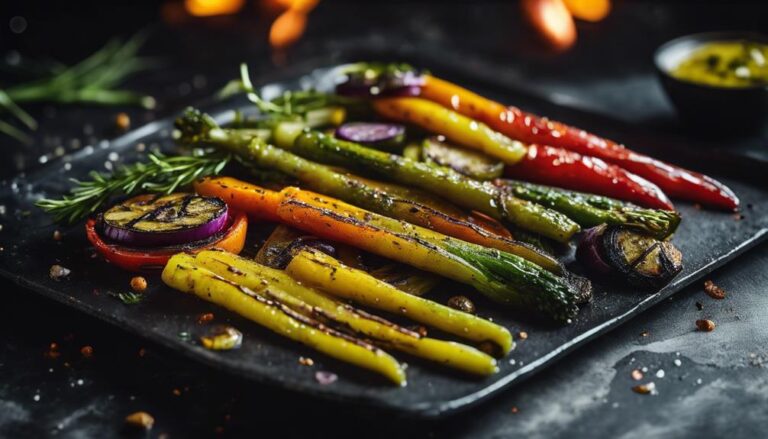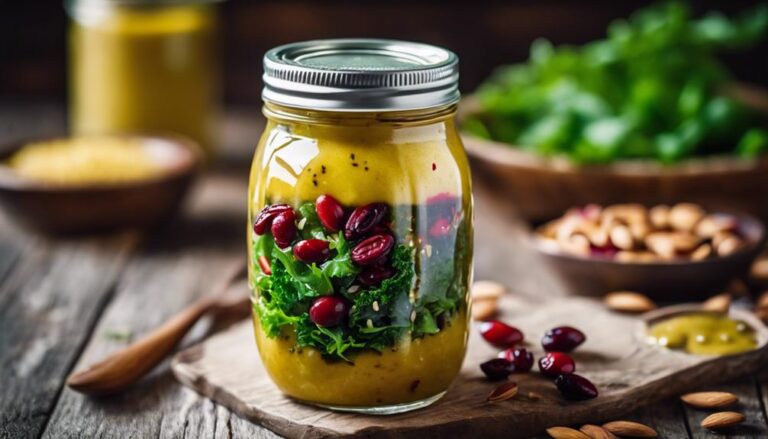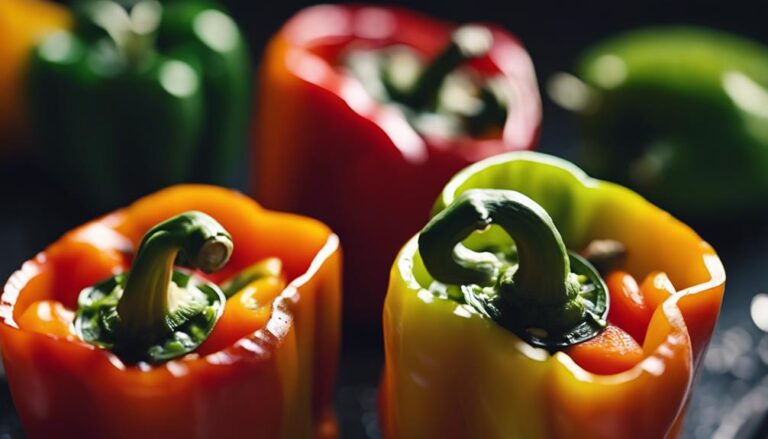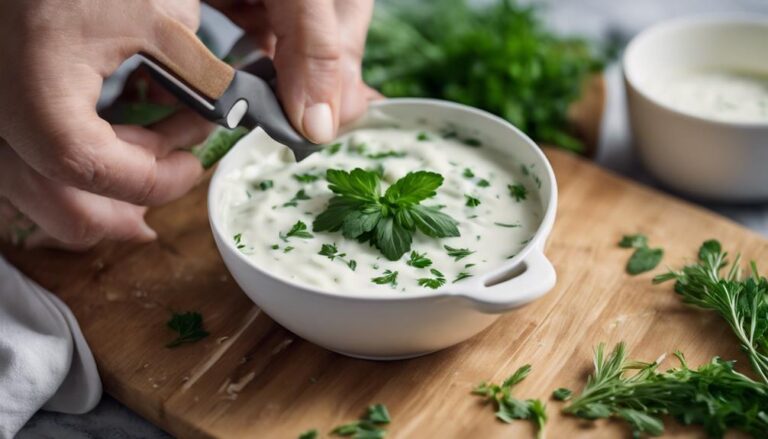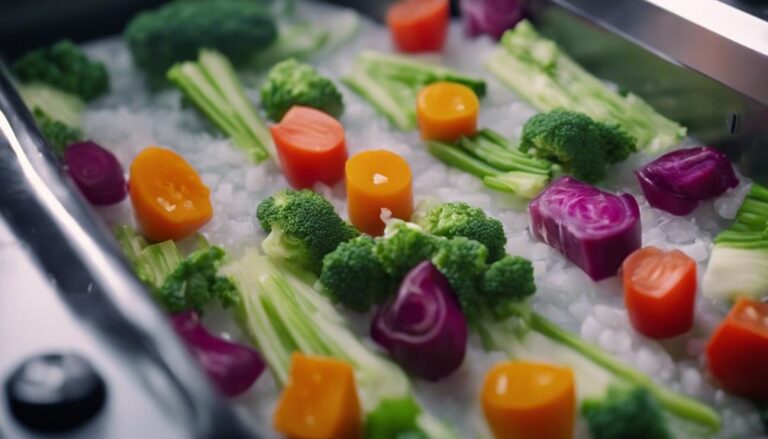Sous Vide Herbal Tea With Lavender and Lemon Balm
To create Sous Vide Herbal Tea with Lavender and Lemon Balm, steep both herbs in water for 45-60 minutes for ideal flavor extraction. This approach maintains steady water temperature, maximizing the herbs' essential oils and fragile qualities. The combination of lavender's soothing properties with lemon balm's invigorating twist results in a intricate, nuanced brew. This technique guarantees a well-balanced, aromatic tea that encourages relaxation. The sous vide process offers a convenient way to enjoy the benefits of these herbs. Elevate your tea experience by exploring these calming blends further.
What You Will Learn Here
- Sous vide maintains precise water temperature for optimal herbal tea extraction.
- Infuse lavender and lemon balm for 45-60 minutes for delicate flavors.
- Water circulation method ensures even flavor extraction for a balanced tea.
- Sous vide method guarantees consistent, aromatic herbal tea every time.
- Slow infusion process preserves herbs' beneficial properties and enhances sensory experience.
Herbal Tea Origins
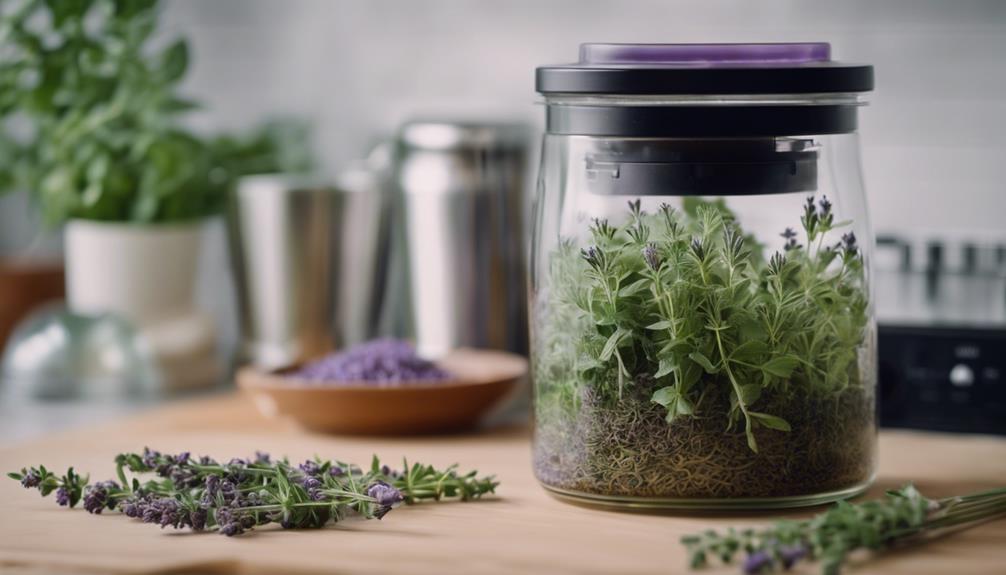
Herbal tea has a rich history spanning back to ancient China, where its consumption was first recorded.
The Egyptians, Greeks, and Romans adopted the practice, incorporating herbal teas into their cultures.
Over time, herbal tea evolved from a medicinal remedy to a beloved beverage enjoyed for its relaxing and therapeutic qualities.
Tea Origins Overview
Tracing back to ancient civilizations such as the Egyptians, Chinese, and Greeks, the consumption of herbal tea has a rich and diverse history. Lavender and lemon balm, two key ingredients in herbal teas, have been cherished for their medicinal properties and calming effects. These herbs have played a significant role in the historical development of herbal teas, with their soothing aromas and potential health benefits.
Across different cultures, the tradition of brewing herbal teas has flourished, leading to a wide array of herbal blends tailored to specific wellness needs. Herbal teas, being caffeine-free alternatives, not only offer an assortment of flavors and fragrances but also provide various health-promoting properties. The evolution of herbal tea-making practices reflects a blend of cultural preferences and ancient medicinal wisdom.
Historical Herbal Tea
With roots stretching back to ancient civilizations, the consumption of herbal tea reveals a fascinating journey through history, showcasing its enduring appeal and cultural significance.
Herbal tea has a rich historical background, with records dating back to ancient China, Egypt, and India. Lavender and lemon balm, known for their medicinal properties, have been integral components of herbal remedies and teas for centuries. Ancient civilizations valued herbal teas for promoting wellness, relaxation, and balance within the body.
Through the ages, the tradition of herbal tea consumption has been passed down through generations, highlighting its sustained popularity and cultural importance. Historical figures and healers have extensively documented the therapeutic benefits of herbal teas like lavender and lemon balm, underscoring their significance in traditional medicine.
Cultural Tea Influences
Originating from diverse ancient civilizations, the cultural influences on herbal tea traditions have shaped unique practices and beliefs worldwide. Lemons, commonly used in herbal teas, have been integral to Mediterranean and Middle Eastern cultures for centuries, known for their invigorating and cleansing properties.
Lavender, with its calming aroma and medicinal qualities, has roots in European herbal medicine and is often associated with relaxation and stress relief. Across different cultures, herbal teas have served various purposes, from aiding digestion in Indian Ayurvedic practices to promoting overall well-being in traditional Chinese medicine.
Understanding the cultural significance behind the ingredients like lemon and lavender in herbal teas can offer insight into the diverse traditions and rituals surrounding the consumption of these soothing beverages.
Herbal Tea Base Ingredients
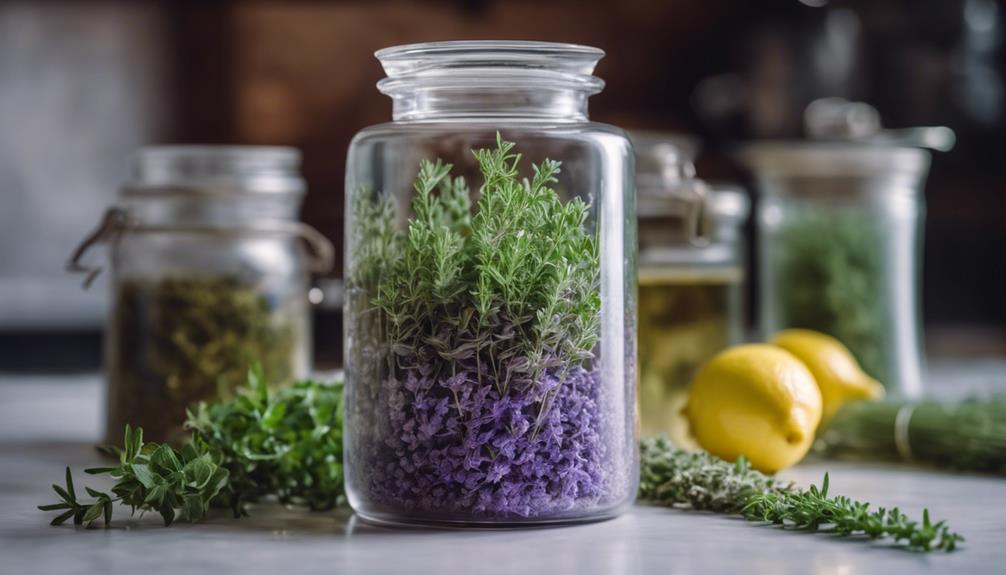
For crafting a flavorful and aromatic sous vide herbal tea, the essential base ingredients include lavender and lemon balm. These botanicals bring a harmonious blend of floral and citrusy notes to your tea experience. Here's why these ingredients are important for creating a delightful infusion:
- Lavender: Known for its calming properties, lavender adds a soothing floral aroma and a subtle sweetness to the tea.
- Lemon Balm: With its bright citrus flavor, lemon balm complements the lavender by providing a rejuvenating and uplifting twist to the blend.
- Combined Benefits: Lavender and lemon balm together create a well-rounded flavor profile that balances floral, citrus, and herbal notes harmoniously.
- Aromatic Complexity: The unique combination of lavender and lemon balm in sous vide herbal tea results in a complex and nuanced brew that tantalizes the senses.
Soothing Lavender Lemon Balm Blends
Calming Lavender Lemon Balm Blends combine the stress-relieving properties of lavender and lemon balm, known for their soothing effects on anxiety and relaxation. The invigorating and fragrant experience offered by this herbal tea blend is a result of the medicinal properties of lavender and lemon balm.
Integrating Lavender Lemon Balm Elixir, Lavender Lemon Balm Infusion, and Lemon Balm Infused Sorbet into your routine can provide a relaxing and tasty way to enjoy the benefits of these herbs.
Lavender Lemon Balm Elixir
Lavender lemon balm elixir, a harmonious blend of lavender and lemon balm, offers an invigorating and stress-relieving herbal beverage. When combined, these two botanicals create a drink that soothes the senses and provides a moment of tranquility. Here are four key aspects of this elixir:
- Calming Properties: Lavender and lemon balm synergize to bring a sense of calmness and relaxation.
- Invigorating Flavor: The elixir boasts an invigorating taste that can uplift your mood.
- Stress Relief: Enjoy a cup of this elixir to unwind and alleviate stress after a long day.
- Versatile Enjoyment: Whether hot or cold, this elixir offers flexibility in how you choose to indulge in its benefits.
Lavender Lemon Balm Infusion
Extracting the harmonious flavors of lavender and lemon balm through precise sous vide temperature control enhances the infusion process for a truly aromatic and beneficial herbal tea blend. When creating a lavender lemon balm infusion, consider the following:
- Calming Properties: Lavender and lemon balm combine to create a calming and soothing tea blend, perfect for relaxation.
- Aromatic Flavors: The infusion process extracts the aromatic essences of lavender and lemon balm, enhancing the sensory experience of the tea.
- Health Benefits: This herbal blend offers antioxidant benefits and can aid in stress reduction and relaxation.
- Synergistic Effect: Lavender and lemon balm work together synergistically, resulting in an invigorating and aromatic beverage that delights the senses.
Through the meticulous sous vide method, you can harness the full potential of these herbs for a truly comforting infusion.
Lemon Balm Infused Sorbet
Opt for incorporating a touch of lemon balm into your sorbet to elevate its flavor profile while promoting a sense of relaxation and stress reduction. The combination of lavender and lemon balm in the sorbet creates a unique and invigorating dessert option that not only tantalizes your taste buds but also offers soothing properties. Here are four ways lemon balm infused sorbet can enhance your experience:
- Flavor Fusion: Lemon balm adds a citrusy and herbaceous note that complements the floral undertones of lavender.
- Relaxing Effects: The infusion of lemon balm in the sorbet can help promote a sense of calmness and relaxation.
- Stress Reduction: Enjoy a scoop of this sorbet to unwind and reduce stress levels naturally.
- Cooling Indulgence: The coolness of the sorbet combined with the aromatic herbs provides a delightful treat for your senses.
Brewing Techniques
Set the temperature precisely to achieve the ideal brewing conditions, allowing for the extraction of delicate flavors.
Control the infusion duration to enhance the aroma and taste profile of the herbal tea.
Employ a water circulation method for uniform heat distribution, ensuring a consistent brew throughout the process.
Temperature for Brewing
To achieve ideal infusion of lavender and lemon balm in sous vide herbal tea, maintain the brewing temperature at approximately 185°F (85°C). This essential temperature is key for extracting the nuanced flavors and beneficial properties of the herbs.
Sous vide brewing guarantees the water stays at a constant temperature, allowing the herbs to gently infuse without losing their delicate qualities. By brewing at this specific temperature, you can maximize the extraction of essential oils and compounds from the herbs, resulting in a well-balanced and aromatic tea.
The controlled environment of sous vide helps create a flavorful beverage with minimal effort, offering a convenient way to enjoy the full potential of lavender and lemon balm in your tea.
Duration of Infusion
Enhancing the flavor extraction of lavender and lemon balm in sous vide herbal tea involves carefully determining the best duration of infusion. Lavender leaves and lemon balm, when infused for around 45 to 60 minutes at a precise temperature, release their delicate flavors and aromatic oils efficiently.
Longer infusion times, up to 2 hours, can intensify the herbal tea's taste, providing a more robust flavor profile. It's essential to monitor the infusion process closely to avoid over-extraction, which could lead to a bitter taste.
Water Circulation Method
For ideal flavor extraction in sous vide herbal tea with lavender and lemon balm, the water circulation method plays a crucial role in maintaining precise temperature control during the brewing process.
When using fresh lavender and lemon balm in sous vide tea preparation, the water circulation method guarantees that the herbs are steeped at a consistent temperature, allowing for a thorough infusion of flavors. This technique prevents uneven steeping, providing a more balanced and aromatic herbal tea.
By circulating the water around the herbs at a controlled temperature, the sous vide method maximizes the extraction of essential oils and compounds from the lavender and lemon balm, resulting in a more flavorful and fragrant beverage.
Embracing this precise water circulation technique elevates the overall tea experience, capturing the essence of the herbs in every sip.
Final Thoughts
In conclusion, the Sous Vide method for preparing herbal tea with lavender and lemon balm provides a refined and consistent tea-drinking experience. By utilizing precise temperature control, Sous Vide guarantees that the flavors of lavender and lemon balm are extracted effectively, resulting in a tea that's rich in aroma and taste. The slow and thorough infusion process enhances the overall sensory experience, making each sip a delight for the palate.
One of the key advantages of using Sous Vide for herbal tea preparation is the convenience it offers. Requiring minimal hands-on time, this method ensures that you'll achieve the same excellent results every time. Additionally, the gentle nature of the Sous Vide process helps to maintain the delicate flavors and beneficial properties of lavender and lemon balm, ensuring that you get the most out of these herbs in every cup.
Frequently Asked Questions
What Is Lemon Balm and Lavender Tea Good For?
Lemon balm and lavender tea is good for health benefits like reducing stress and promoting relaxation. It offers a soothing flavor profile perfect for unwinding. Regular consumption may aid in better digestion and contribute to overall well-being.
Who Should Not Take Lemon Balm?
If you're pregnant, avoid lemon balm due to its potential to stimulate the uterus. For children under 12, steer clear of lemon balm's sedative effects. Consulting your healthcare provider before use is important for those with specific conditions.
What Does Lemon Balm Do to the Brain?
Lemon balm, a herb with GABA-affecting properties, improves cognition and memory while reducing anxiety. It interacts with brain pathways, offering calmness. The rosmarinic acid in lemon balm protects brain cells and shows potential in managing neurodegenerative conditions like Alzheimer's.
Can You Drink Too Much Lemon Balm Tea?
You should exercise caution when consuming lemon balm tea. Health benefits such as stress relief exist, but excessive intake may lead to adverse effects like dizziness or digestive problems. It's wise to adhere to recommended dosages and consult professionals if needed.
Conclusion
To sum up, sous vide herbal tea with lavender and lemon balm offers a soothing and aromatic blend that's both calming and invigorating.
By infusing these herbs at a precise temperature, the flavors and benefits are maximized, resulting in a truly unique and delicious beverage.
This method of brewing allows for a more controlled extraction of flavors, ensuring a consistent and enjoyable cup of herbal tea every time.
Try this recipe to experience the full potential of these natural ingredients.
